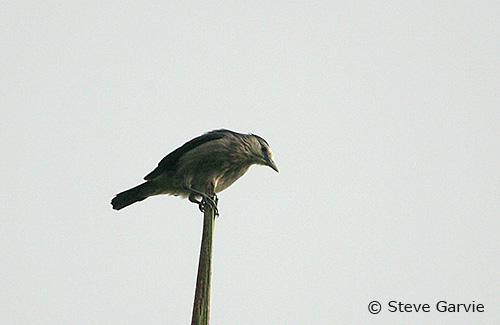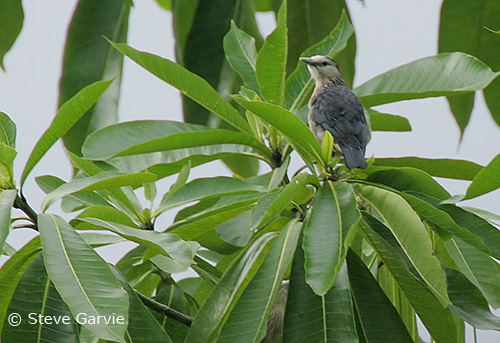
Fr: Etourneau de Ceylan
Ang: White-faced Starling
All: Greisenstar
Esp: Estornino Cingalés
Ita: Storno facciabianca
Nd: Maskerspreeuw
Sd: ceylonstare
Photographers:
Steve Garvie
RAINBIRDER Photo galleries
Alan & Ann Tate
AA Bird Photography
Text by Nicole Bouglouan
Sources:
HANDBOOK OF THE BIRDS OF THE WORLD Vol 14 by Josep del Hoyo-Andrew Elliot-David Christie - Lynx Edicions – ISBN: 9788496553507
Starlings and Mynas by Adrian Craig, Chris Feare – Helm Identification Guides -Bloomsbury Publishing, 2010 – ISBN: 1408135205, 9781408135204
Fatbirder - The World’s Richest Information Resource about Birds for Birders
Wikipedia, the free encyclopaedia
Home page
Page Order Passeriformes
White-faced Starling
Sturnornis albofrontatus
Passeriformes Order – Sturnidae Family
INTRODUCTION:
The White-faced Starling is endemic to Sri Lanka. It is found in the wet zone in the SW of the island, where it frequents tall forests high in canopy.
It is primarily arboreal and rarely descends to the ground. It feeds mainly on fruits, but nectar and insects are also part of the diet.
It nests in tree cavity, often at high elevations. It lives in pairs or in small flocks.
The White-faced Starling, like numerous Sri Lankan species, is threatened by extensive clearance and degradation of forests in the wet zone, including some protected wooded areas.
The species is currently listed as Vulnerable.

DESCRIPTION OF THE BIRD:
Biometrics:
Length: 20-22 cm (21,6 cm)
The White-faced Starling has greyish upperparts. The feathers of crown, nape and upper mantle are elongated and ruffled. They are dull greyish-black with white shafts forming a white streaked pattern. Both upperwing and tail are black with soft greenish gloss.
The underparts are paler. Breast, upper belly and flanks are brownish-grey. Here again, the white shafts of the feathers form a streaked pattern. Lower belly and undertail-coverts are whitish.
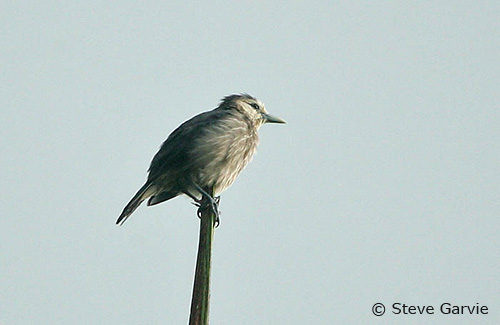
On the head, crown and nape are dull grey-black. Forehead, head sides, chin and throat are white or sometimes washed with grey.
The bill is greyish to horn-coloured, but the base is blue-grey.
The eyes are brown, surrounded by grey outer ring, but they also may be white with red-brown inner ring, or white. The area around the eye is sometimes made of bluish bare skin.
Legs and feet are bluish-grey.
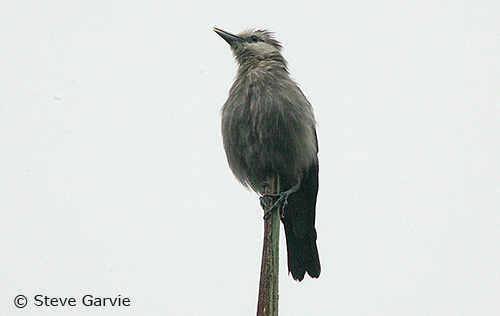
Male and female are similar in plumage, but the female is somewhat smaller.
The juvenile has browner upperparts and greyer underparts. The white streaking of the breast is absent.
The eyes are brown with faint outer ring. The white parts of the head appear during the first year.
RANGE:
The White-faced Starling is found in SW Sri Lanka.
HABITAT:
The White-faced Starling has a narrow altitudinal range, between 300 and 1,200 metres of elevation. It prefers undisturbed natural forests where it usually occurs high in the canopy.
It is confined to the tall forests on the wet zone and the adjacent areas. There, it visits fruiting-trees and villages within the forest. It is mostly seen below 1,000 metres.
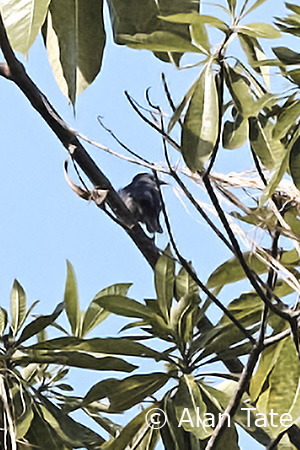
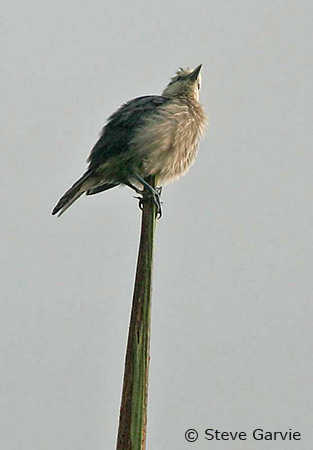
CALLS AND SONGS: SOUNDS BY XENO-CANTO
The call of the White-faced Starling is mostly heard when the birds form small flocks. They produce short chirps, but this species also gives sharp, high-pitched, downslurred “cheewp” also described as “cheow”.
When gathering in flocks, they often sing for extended periods.
The song is a soft, sweet vocalization. The male sings to advertise the territory and to attract a mate.
The females sing much less than males.
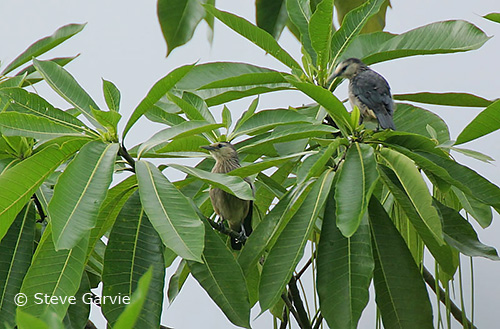
BEHAVIOUR IN THE WILD:
The White-faced Starling feeds mainly on fruits, nectar and insects, the latter especially during the breeding season.
The fruit diet includes berries of Cinnamomum, and fruits of figs (Ficus). It also takes the nectar of the red cotton tree (Bombax) and Grevillea (family Proteaceae).
This species is almost exclusively arboreal and rarely seen on the ground. It usually remains high in the canopy among the tree tops.
It commonly joins mixed-feeding flocks at abundant food sources such as fruiting trees.
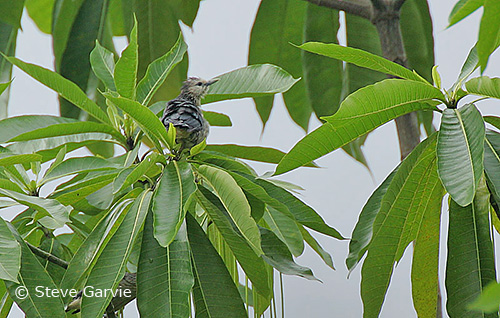
The breeding behaviour of the White-faced Starling is very poorly known. The courtship displays are unknown, but they are probably modest, as both mates have similar appearance.
This species nests in tree cavity where two eggs are laid.
The White-faced Starling is resident endemic breeder in SW Sri Lanka. It does not need to move for food resources.
The flight of this species is strong and direct with rapid wing-beats and short glides.
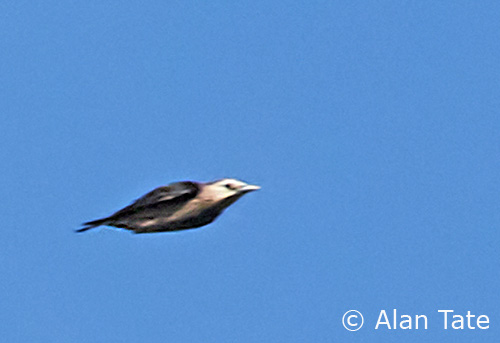
REPRODUCTION OF THIS SPECIES:
The breeding season takes place from April to August.
The White-faced Starling nests in tree holes at fairly high elevations. There may sometimes be some nesting material in the nest, a few twigs placed there by the female, but some cavities offer only bare wood for the eggs.
The only nest recorded in April by Frederick Lewis many years ago, contained two pale blue eggs lying on the bare wood.
More information is needed.
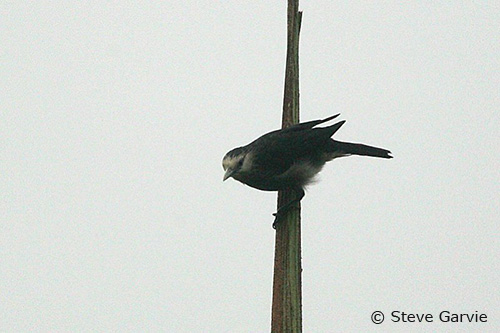
PROTECTION / THREATS / STATUS:
The White-faced Starling is threatened by extensive clearance involving the degradation of the forests, especially in the wet zone. As usual, logging, fuelwood collection, agriculture expansion, gem mining, settlement and fire destroy the habitat of this species. In addition, some protected forests are also degraded, causing future fragmentation.
However, the White-faced Starling is present in several National Parks and forest reserves.
The size of the population is roughly estimated at 3,500/15,000 individuals. It is suspected to be decreasing at a moderate rate, due to habitat loss.
The White-faced Starling is currently listed as Vulnerable.
